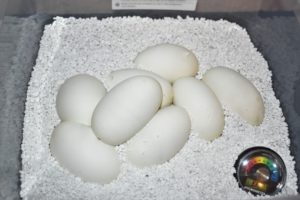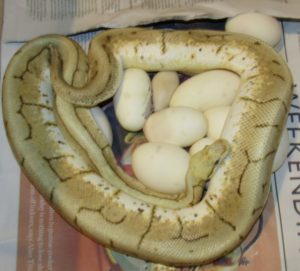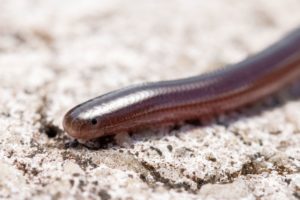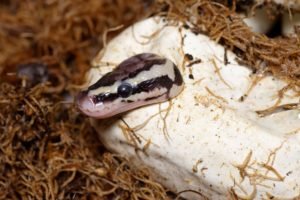Do female Ball Pythons lay eggs without a male? In some cases, yes – but you need to understand the logic behind asexual reproduction to predict when.
Parthenogenesis, or reproduction without a male, occurs in a wide array of vertebrates, including some squamate (snake and lizard) species. This includes the Ball Python (Python regius). It isn’t common, and you should by no means expect it, but it is well documented by both scientists and hobbyist keepers.
Can a Ball Python lay eggs without a male?
Ball Pythons can indeed lay eggs without a male, despite being a species with two sexes. This is a process called facultative parthenogenesis. In a nutshell, the female creates gametes (ova) that become young without the genetic input (sperm) of a male. We say it is facultative, rather than obligate, because the species also has the option of reproducing sexually.
Most scientists agree that this is a form of asexual reproduction. It’s important to remember, however, that it is different from the asexual reproduction used by bacteria, which is called binary fission. The main difference being that in this case egg cells are produced and used.
In Ball Pythons, the babies that result from parthenogenesis are all female clones of the mother. This makes them perfect, healthy little replicas that have exactly the same genes. A Pastel female would create Pastel female babies, for example.
When it comes to the cellular mechanisms and latest research on this subject, it get’s very complicated. Nonetheless, if you would like to read more about it, I’ve attached some reading material at the end of this article.
For now, let’s start off by thinking about why parthenogenesis occurs.

Why does parthenogenesis happen?
Parthenogenesis occurs when sexual reproduction is:
- impossible
- difficult
- highly detrimental
- unecessary
The classic example of facultative parthenogenesis is when a female animal such as a lizard arrives on a desert island. This could be after a long swim, or after floating on vegetation. On the island there’s no other lizards, and probably never will be. So, Miss lizard takes things into her own hands and becomes a mum without any help from a male.
This sounds far-fetched but makes a lot of sense when you think about it. After all, that lizard cannot know whether any of its species is still alive elsewhere. For all it knows, it could be the last of its kind. In evolutionary terms, survival and the passing on of genes is all that matters. So at this point, if mother nature can make it happen, she will.
If you still need convincing, ponder for a moment the fact that the Komodo Dragon (Varanus komodoensis) is facultatively parthenogenic, a great swimmer, and now lives only on a handful of tiny islands.
In other circumstances, females may simply be avoiding sexual reproduction because they find themselves in a highly inbred population. In this case, producing healthy clones of yourself is better than producing inbred babies with another animal.

Difference between parthenogenesis and delayed fertilisation
Where things get a little confusing with Ball Pythons is that as well as being facultatively parthenogenic, they also store sperm. After copulating, the females store sperm in what are basically folds in their reproductive tracts.
It is thought that these folds become sealed pockets and probably even keep the sperm supplied with nutrients to keep them alive. If temperatures are in a comfortable range, female Ball Pythons can store sperm for anywhere from 3 months to several years. So, even if your female copulated 5 years ago, there’s still a chance she could use stored sperm to fertilise and lay eggs!
Again, this delayed fertilisation serves a purpose. It allows females in the wild to synchronise the hatching of their eggs with the season where food will be most abundant. After all, they want their babies to hatch out and have lots of prey to hunt.
Oldest Ball Python in captivity
A while back you may have noticed a flurry of online articles regarding a very special Ball Python at the St. Louis Zoo in Missouri, USA. The female in question was probably the oldest Ball Python in captivity at over 50* years old. But more to the point, she also laid a healthy clutch of eggs through parthenogenesis.
This was a perfect example of facultative parthenogenesis in action. Said female had been kept alone for 15 years and decided to take things into her own hands (manner of speaking…). that is really all it boils down to.
To be clear, sperm storage is very unlikely in this scenario given the time span: Sperm is fragile and not realistically going to be viable after 15 years.
*For some reason, various media outlets reported the Ball Python to be 62 years old. According to St. Louis Zoo, however, she was around the 50 mark.
Can other snakes lay eggs without a male?

There are several other species of snake that can lay eggs without a male. Burmese Pythons (Python bivittatus) and Reticulated Pythons (Malopython reticulatus), for example, have documented cases of parthenogenesis. Unsurprisingly, this produces all female offspring, as in Ball Pythons.
Taking things even further is the Brahminy Blind Snake (Indotyphlops braminus). Also known as the Flowerpot Snake, this all-female species is obligate parthenogenetic. Why exactly is has evolved (or hybridised?) to be this way is still somewhat of a mystery. If it is through evolution, the only reason that could explain it would be its lifestyle. Brahminy Blind Snakes are tiny and highly fossorial; I suppose this could in theory make finding mates difficult.
Out of the numerous live-bearing snake species, there are also several that regularly reproduce through facultative parthenogenesis. The most closely studied so far have been the Copperhead (Agkistrodon contortrix) and the Cottonmouth (Agkistrodon piscivorus).
The difference here is that all the babies are male, and many tend to be either deformed or stillborn. This leads some people to think that these babies are half-clones, which makes them extremely inbred and would explain the poor viability. Again, this is a complicated topic, but you can explore it further in the reading material in the final section of this article.
Table: Snakes that reproduce through parthenogenesis
| Species: | Obligate or facultative: |
| Ball Python (Python regius) | Facultative |
| Red Tail Boa (Boa constrictor) | Facultative |
| Brazilian rainbow boa (Epicrates cenchria) | Facultative |
| Burmese python (Python bivittatus) | Facultative |
| Reticulated python (Malopython reticulatus) | Facultative |
| Checkered garter snake (Thamnophis marcianus) | Facultative |
| Brahminy Blind Snake (Indotyphlops braminus) | Obligate |
| Copperhead (Agkistrodon contortrix) | Facultative |
| Cottonmouth (Agkistrodon piscivorus) | Facultative |
Can male snakes lay eggs?
Male snakes cannot lay eggs. That said, I still get asked this on a regular basis. The reason for this is probably that there are in fact many hermaphroditic species of animal. Some of these even change gender over the course of their lifetime.
Remember Nemo – from that extremely popular movie? Well, Nemo was a Clownfish. In the wild, Clownfish actually start off as males, then grow up and change into females. I guess this is kind of a situation where a “male” animal will eventually lay eggs. So far though, there is no known snake species in which this kind of sequential hermaphroditism occurs.

Signs a Ball Python is about to lay eggs
So, what if you have a female Ball Python that’s looking a little overly chunky? How do you know if she’s going to lay eggs?
There are a few signs to look out for, whether you suspect parthenogenesis or not. First is unexplained weight gain, despite being full grown and having been maintained on the same feeding routine. If she’s 2kg in weight and packs on 400g over the course of two months, something is happening…
The second is loss of appetite. A female Ball Pythons will almost certainly stop eating and continue to get fatter when gravid. Often, the eggs take up so much room that eating isn’t an option.
Third is nesting behaviour. Nesting Ball Pythons will hug the warm spot, gather up the substrate, and generally rearrange their enclosure for a couple of weeks before laying. Sometimes it will look like they’ve tried to trash the place.
Last but not least, don’t forget those female Ball Pythons almost always shed roughly 30 days before laying. If you own a female, it’s always a good idea to make a note of when they shed so that you can do the math if necessary.
If you do end up with unexpected eggs, check out my Ball Python egg incubation and DIY Ball Python incubator articles (below) for more help.
Also on this topic:
For more on Ball Python eggs:
Back to the Ball Python eggs and incubation page
